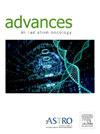低收入和中等收入国家诊断为局限性前列腺癌的男性治疗后的结果和毒性:系统回顾和荟萃分析
IF 2.2
Q3 ONCOLOGY
引用次数: 0
摘要
目的:目前在低收入和中等收入国家(LMICs),临床上局限性前列腺癌的治疗包括手术、外束放射治疗(EBRT)和近距离治疗(单独或联合),以及加或减激素治疗。这些治疗方式的毒性概况和肿瘤学结果各不相同。本系统综述和荟萃分析旨在确定低收入国家诊断为局限性前列腺癌的男性的治疗相关结局和毒性的患病率。方法和材料:本综述根据系统评价和荟萃分析指南的首选报告项目进行。检索Cochrane Library、Embase和Medline等符合条件的文章。meta分析采用Review Manager 5.4.1版本,采用随机效应模型,置信区间为95%。结果:符合纳入标准的24篇文献共分析2820例患者。在三维适形放射治疗(3D-CRT)后,最常见的临床报告毒性分别为急性皮肤1级、急性泌尿生殖系统1级、急性胃肠道1级和晚期胃肠道1级,分别为46%、29%、24%和18%。急性和晚期泌尿生殖系统3级和胃肠道3级毒性低于3%,3D-CRT后无4级毒性报告。在近距离治疗组中,急性泌尿生殖系统1级毒性发生率为19%。耻骨后根治性前列腺切除术后围手术期直肠损伤发生率最低(2%)。3D-CRT组5年总生存率为87%,近距离放疗联合EBRT组5年总生存率提高至96%。EBRT和近距离放疗后5年生化失败的发生率分别为18%和30%。根治性前列腺切除术和EBRT联合近距离治疗后4年和3年生化失败率分别为22%和2%。结论:本系统综述和荟萃分析表明,在中低收入人群中,EBRT、近距离治疗和根治性前列腺切除术,无论是单独治疗还是联合治疗,都具有低毒性和良好肿瘤预后的局限性前列腺癌控制的良好潜力。治疗相关毒性和结局的结果可以支持决策者、患者和临床医生做出明智的决策,以加强该地区的前列腺癌护理。然而,需要努力改善早期发现、治疗可及性、定期治疗后随访护理、一致的质量保证实践和工作人员的持续发展,以帮助最大限度地减少治疗毒性并改善中低收入国家局限性前列腺癌的预后。本文章由计算机程序翻译,如有差异,请以英文原文为准。
Outcomes and Toxicities After Treatment for Men Diagnosed With Localized Prostate Cancer in Low- and Middle-Income Countries: A Systematic Review and Meta-Analysis
Purpose
Current management for clinically localized prostate cancer in low- and middle-income countries (LMICs) includes surgery, external beam radiation therapy (EBRT), and brachytherapy either alone or in combination, with plus or minus hormone therapy. The toxicity profiles and oncological outcomes of these treatment modalities vary. This systematic review and meta-analysis aimed to determine the prevalence of treatment-related outcomes and toxicities for men diagnosed with localized prostate cancer in LMICs.
Methods and Materials
The review was conducted based on the Preferred Reporting Items for Systematic Reviews and Meta-Analyses guidelines. Cochrane Library, Embase, and Medline were searched for eligible articles. Meta-analysis was performed with Review Manager version 5.4.1 using a random effects model at a 95% confidence interval.
Results
A total of 2,820 patients were analyzed from 24 articles that met the inclusion criteria. Following 3-dimensional conformal radiation therapy (3D-CRT), the most common clinician-reported toxicities were acute skin grade 1, acute genitourinary grade 1, acute gastrointestinal grade 1, and late gastrointestinal grade 1, with 46%, 29%, 24%, and 18%, respectively. Acute and late genitourinary grade 3 and gastrointestinal grade 3 toxicities were below 3% with no grade 4 toxicities reported after 3D-CRT. In the brachytherapy group, the prevalence of acute genitourinary grade 1 toxicity was 19%. Perioperative rectal injury was the least prevalent (2%) after retropubic radical prostatectomy. Following 3D-CRT, the 5-year overall survival rate was 87%, and for the combined brachytherapy and EBRT group, it increased to 96%. The prevalence of 5-year biochemical failure following EBRT and brachytherapy was 18% and 30%, respectively. The 4- and 3-year biochemical failure after radical prostatectomy and combined EBRT with brachytherapy were 22% and 2%, respectively.
Conclusions
This systematic review and meta-analysis indicate that in LMICs, EBRT, brachytherapy, and radical prostatectomy, either alone or in combination has an excellent potential for localized prostate cancer control with low toxicities and good oncological outcomes. Results of treatment-related toxicities and outcomes can support policymakers, patients, and clinicians on informed decision-making to strengthen prostate cancer care in the region. However, efforts are required to improve early detection, treatment accessibility, regular post-treatment follow-up care, consistent quality assurance practices, and staff continues development to help minimize treatment toxicities and improve outcomes of localized prostate cancer in LMICs.
求助全文
通过发布文献求助,成功后即可免费获取论文全文。
去求助
来源期刊

Advances in Radiation Oncology
Medicine-Radiology, Nuclear Medicine and Imaging
CiteScore
4.60
自引率
4.30%
发文量
208
审稿时长
98 days
期刊介绍:
The purpose of Advances is to provide information for clinicians who use radiation therapy by publishing: Clinical trial reports and reanalyses. Basic science original reports. Manuscripts examining health services research, comparative and cost effectiveness research, and systematic reviews. Case reports documenting unusual problems and solutions. High quality multi and single institutional series, as well as other novel retrospective hypothesis generating series. Timely critical reviews on important topics in radiation oncology, such as side effects. Articles reporting the natural history of disease and patterns of failure, particularly as they relate to treatment volume delineation. Articles on safety and quality in radiation therapy. Essays on clinical experience. Articles on practice transformation in radiation oncology, in particular: Aspects of health policy that may impact the future practice of radiation oncology. How information technology, such as data analytics and systems innovations, will change radiation oncology practice. Articles on imaging as they relate to radiation therapy treatment.
 求助内容:
求助内容: 应助结果提醒方式:
应助结果提醒方式:


